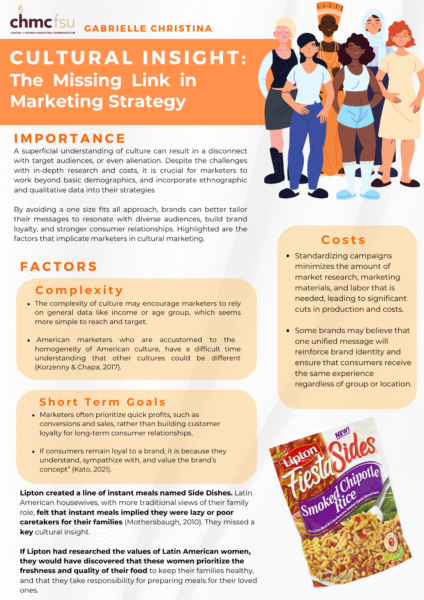Cultural Insight: The Missing Link in Marketing Strategy
November 8, 2024

By Gabrielle Christina – Florida State University – Hispanic Marketing Communication
Why do some marketing campaigns fail to resonate? The answer may lie in a critical oversight; culture. Marketers and agencies often underestimate the power of culture in shaping consumer behavior. According to Sasu, to gain profit and satisfy the target market, the culture must be understood (Sasu, 2005). Marketers often study demographics, economic conditions, and product features, overlooking the deeper aspects of cultural identities. To customize a message to different groups of people, the marketing strategy must recognize the psychographics and behaviors of those target audiences. Failing to do so can result in campaigns that fail to connect or, worse, offend different cultures. What works for one group might be inappropriate or offensive to another. Even though the ramifications of neglecting cultural marketing are prevalent, marketers still overlook it because of complexity, short term goals, and costs. This essay will explore the implications that are involved in cultural marketing.
The study of cultural marketing is a complex, multi-layered process that is daunting to some marketers. It requires deep research and understanding that may take months or years to fully acquire the knowledge that is needed. According to Chapa and Korzenny, American marketers who are accustomed to the homogeneity of American culture, have a difficult time understanding that other cultures could be different (Chapa & Korzenny, 2017). For example, to reach Hispanic people as a heterogeneous group, it’s not as simple as playing Spanish music or the traditional Spanish language in an ad—there are significant differences in ethnicity within this enormous group, reflected in their cuisine, religion, traditions, dialect, family roles, and more. Marketers must study the intricacies of the specific segment they wish to target through ethnographic and qualitative research, which is not an easy task, but a necessary one. The complexity of culture may encourage marketers to rely on general data like income or age group, which seems simple to reach and target.
Marketers may overlook culture because their goals are driven by short-term metrics.
They prioritize quick profits, such as conversions and sales, rather than building customer loyalty for long-term consumer relationships. However, brand loyalty is critical for the continuous success of a brand. As Kato’s study highlights, “if consumers remain loyal to a brand, it is because they understand, sympathize with, and value the brand’s concept” (Kato, 2021). When members of a cultural group perceive a brand as connected to their culture, they are more likely to stay loyal. All marketers must understand and value this to sustain the relevance and loyalty to their brand.
Standardization, the practice of using a uniform strategy or campaign across different markets to achieve efficiency and reduce cost, contributes to the neglect of culture within marketing. Standardizing campaigns among different groups of people minimizes the amount of market research, marketing materials, and labor that is needed, leading to significant cuts in production and costs. Some brands may believe that one unified message will reinforce brand identity and ensure that consumers receive the same experience regardless of group or location.
Managing a single, global campaign may be simpler, but one size doesn’t always fit all. For example, an anecdote from Motherbaugh highlights how Lipton created a line of instant meals named Side Dishes. The meals sold well in the United States, but not in Latin America, a large market that Lipton hoped would fuel growth for the line. Latin American housewives, with more traditional views of their family role, felt that instant meals implied they were lazy or poor
caretakers for their families (Mothersbaugh, 2010). If Lipton had researched the values of Latin American women, they would have discovered that these women prioritize the freshness and quality of their food to keep their families healthy, and that they take responsibility for preparing meals for their loved ones.
To conclude, the oversight of culture in marketing practices can have significant repercussions, leading to missed opportunities. A superficial understanding of culture can result in a disconnect with target audiences, or even alienation. Despite the challenges with in-depth research and costs, it is crucial for marketers to work beyond basic demographics, and incorporate ethnographic and qualitative data into their strategies. By avoiding a one size fits all approach, brands can better tailor their messages to resonate with diverse audiences, build brand loyalty, and stronger consumer relationships.

References
- Chapa, J., & Korzenny, F. (2017). Hispanic marketing communication: Principles and practices.
Routledge. - Kato, T. (2021). Brand loyalty explained by concept recall: Recognizing the significance of the
brand concept compared to features. Journal of Market Analysis. - Sasu, C. (2005). Marketing international. Editura Polirom.
School of Communication. (2022, June 22). Why is culture underestimated in marketing? Florida - State University College of Communication & Information.
Motherbaugh, R. (2010). Consumer behavior: Building marketing strategy. McGraw-Hill





























